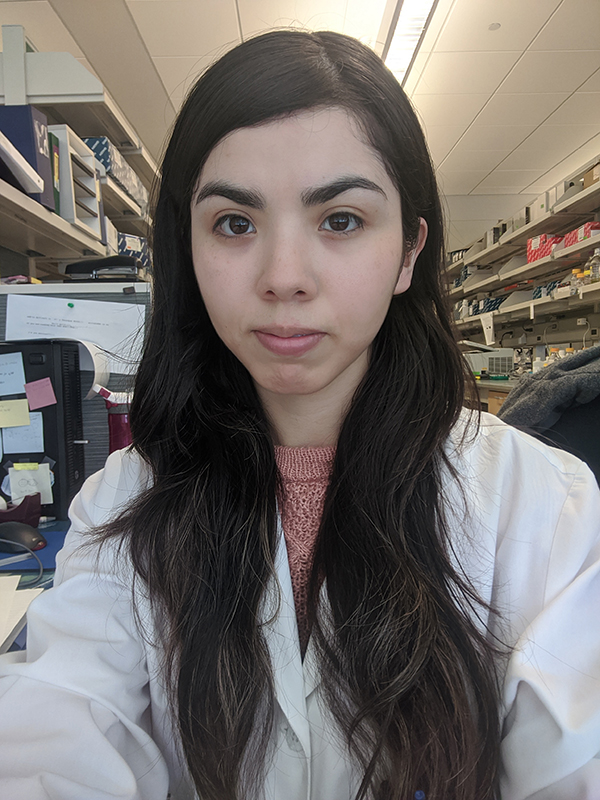From a rare neurologic disease to a potential antiviral medication against corona virus
By Elisabeth Paymal, Center for RNA Biomedicine
As soon as COVID-19 information was released, RNA biologist and child neurologist Dr. Vivian Cheung looked at what was known about this new RNA virus.
 “What I saw was amazingly surprising: the RNA of the virus encodes a familiar protein, the one that I’ve studied for years in a very rare neurodegenerative disease. Here it was, in the RNA of the COVID-19 virus!”
“What I saw was amazingly surprising: the RNA of the virus encodes a familiar protein, the one that I’ve studied for years in a very rare neurodegenerative disease. Here it was, in the RNA of the COVID-19 virus!”
Left: RNA in the clover loop form. Drawing by Colleen McGarry
For decades Dr. Cheung has studied a very rare disease, similar to Amyotrophic Lateral Sclerosis (ALS) but that manifests itself early in teenage years and evolves very slowly. Named ALS4, this rare disease is caused by a mutation in a gene called senataxin, which is an RNA helicase that relaxes the RNA shape.
The coronavirus genome is much smaller than the human one. The virus has a genome of 30,000 nucleotides while humans have three billion of them. The virus makes only 20 different proteins, while humans make 25-30,000 proteins. To be able to observe the similarity between a particular protein of the corona virus that also exists in a rare mutation of the human genome was extremely fortunate.
So why would a virus need this unusual protein? “It turns out that this virus is particularly clever,” explains Dr. Cheung. “When the virus gets in the human cell, its first job is to copy itself so it can spread. It needs to make many copies of its RNA. However, the RNA copying machineries of the virus need to differentiate between the viral and the human RNA. The virus RNA makes a unique folding pattern (a clover leaf shape and a stem-loop). But then, the viral folded RNA needs to be relaxed by the helicase for all the machinery to copy it. This is where our excellent knowledge about this specific RNA helicase process comes in, so we can find ways to disrupt the virus copying process.”
This set of proteins and mechanisms are similar between all the corona viruses that cause SARS, MERS, COVID-19 as well as a third of the common colds. Dr. Cheung and her team are now looking for a therapy that targets these shared properties in the virus multiplication process. This therapy could treat all existing corona virus infections as well as potential upcoming ones.
“We couldn’t do any of this without having had the privilege of studying this very rare neurodegenerative disease,” adds Dr. Cheung, “and it goes back to the 17th century.” In 1664, a large family with a rare muted gene disease came from England to Maryland. This genetic disease has kept transmitting from generation to generation, and, about 25 years ago, the family worked with Johns Hopkins University to find the gene that causes the disease. In the last several years, thanks to these patients and others, and with extensive collaborations between labs, scientists have been able to better understand RNA sequences and shapes, and can now apply what they have learned to target the corona virus copying mechanisms.
The Cheung’s project team has established collaborations with virologists who can access human cells infected with the coronavirus that causes COVID19, through the NIH National Institute of Allergy and Infectious Diseases and National Institute of Neurological Diseases and Stroke. It is also partnering with a pharmaceutical company that will help develop reagents to disable this protein. Dr. Cheung is hopeful that “therapeutic breakthroughs are only months away, not years.”
Vivian Cheung, M.D., is an investigator of the Howard Hughes Medical Institute, Frederick G.L. Huetwell Professor of Pediatric Research at the University of Michigan Medical School, Professor at the U-M Life Sciences Institute, and a Member of the University of Michigan Center for RNA Biomedicine. Her team includes Jason Watts, M.D., Ph.D., Clinical Lecturer and Research Fellow, Internal Medicine, University of Michigan Medical School, and University of Michigan post baccalaureate student Prisila Ramirez.
About the patient family and ALS4
 .
.
Left: Jason Watts, M.D., Ph.D., Clinical Lecturer and Research Fellow, Internal Medicine, University of Michigan Medical School; Right: Prisila Ramirez, University of Michigan post baccalaureate student
